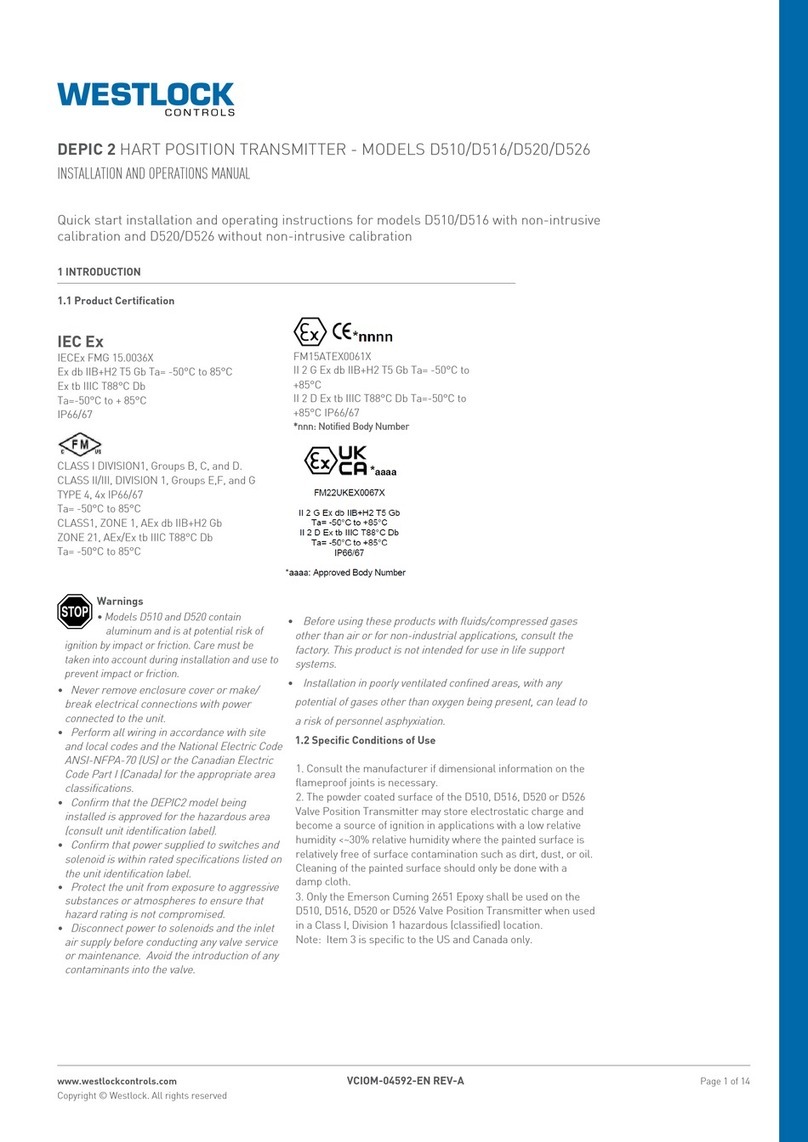
Page 8 of 14VCIOM-04592
DEPIC 2 HART POSITION TRANSMITTER - MODELS D510 AND D520
INSTALLATION AND OPERATIONS MANUAL
5.10 The following setting is dependent on the
pressure sensor-2 configuration. If the
user has disabled the pressure sensor-2
in the previous step, the DEPIC-2 will skip
this step otherwise the LCD will display
the following screen to configure the
DEPIC-2 for the pressure sensor-2 usage.
Use the up/down arrow key to change the
selection between “Supply Pressure” and
“Actuator Chamber Pressure”. Press the
Select key to accept the current selection.
Supply
Pressure:The DEPIC-2 will assume the
pressure sensor-2 is pneumatically
connected to monitor the supply
pressure. It will show all pressure-2
related hysteresis and alarm settings
in the full menu later on to monitor
the supply pressure. The user must
have purchased a DEPIC-2 model
that has the pressure sensor-2.
Actuator
Pressure:
The DEPIC-2 will assume the
pressure sensor-2 is pneumatically
connected to monitor the second
chamber of the actuator. It will show
all pressure-2 related hysteresis
and alarm settings in the full menu
later on to monitor the pressure in
the second actuator chamber. The
user must have purchased a DEPIC-2
model that has the pressure sensor-2.
Press-2 Use10/13
------------------
5.11
This step is dependent on the current
clock configuration. If the DEPIC-2 has the
valid time preconfigured from the factory,
it might skip this step to configure the
clock otherwise it will display the following
screen to configure the clock on the device.
Use the up/down arrow key and the select
key to configure the date and time. The
date must be configured in Month/Day/Year
format and the time must be configured in
Hours: Minutes in 24 hours format.
Clock Setup11/13
------------------
Set time in 24hr
5.12 This step is dependent on the setting
“Device Control” configured in the
previous step. If the user has disabled the
“Device Control” in the previous step, the
DEPIC-2 will display the screen to run the
manual calibration. If the user has enabled
the “Device Control” setting in the previous
step, the DEPIC- 2 will display screen to
run the auto calibration. Use the up/down
arrow key to change the selection between
“Yes” and “No”. Press the Select key to
accept the current selection.
NOTE
If ‘AUTO CALIBRATION’ has been selected, please
ensure that the correct pneumatic (see Section 3.1
and 3.2)/ electrical connections (see Figure 4.1) have
been made and are turned on and the solenoid voltage
connections have been made.
Auto Cal 12/13
------------------
This will move valve &
erase Baseline PST &
FST Data.
Continue?
No
6 USER INTERFACE
6.1 The DEPIC2 position transmitter has both
an on-board keypad/LCD menu structure
and/or a HART menu structure that can be
accessed by pressing the Select button or
from the Main Menu of a HART host. Exit
any function by pressing the up arrow
button to back out of any keypad menu or
the back arrow on the 475.
6.2 The basis of the menu systems of the
DEPIC2 were developed with a HART DD
and are emulated by the Push Button/
LCD menu system so once someone
gets used to using one interface, it
becomes easy to navigate the other
interface. See the following sections on
Configuring and Calibrating the DEPIC2.
While the menus shown below more closely
illustrate the Push Button/LCD, the HART
DD menus are very similar if not identical.
6.3 From the keypad/LCD interface, if the
device is not configured when first powered
up, it will ask the user to run the setup
wizard when the user tries to access the
menu screen. If the user selects to run
the setup wizard, it will ask the user to
configure some basic settings step by step
and perform the calibration. The setup
wizard is only available using keypad/LCD
not on the HART DD.
Copyright © Crane Co. All rights reserved




























